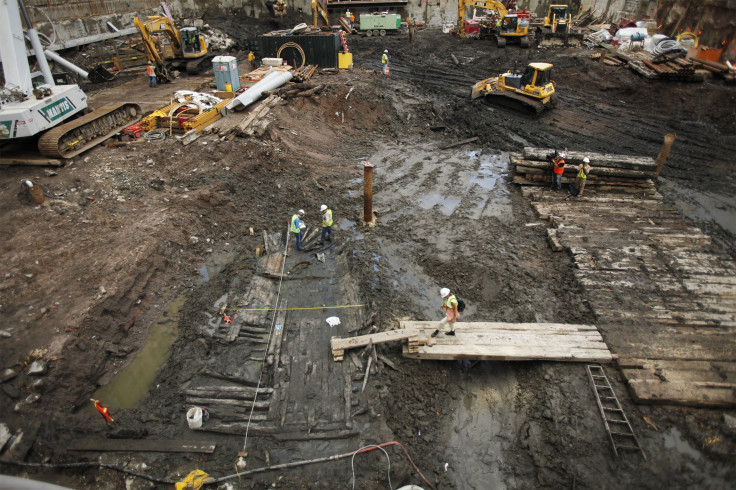World Trade Center Ship: Origin Of Mysterious Centuries-Old Vessel Revealed In New Study

Four years ago, excavators in Lower Manhattan unearthed a centuries-old wooden ship buried 22 feet below street level at the construction site of One World Trade Center. Workers were stunned to find the 30-foot vessel hiding just below their feet, and curiosity about the ship's origin quickly escalated. Today, scientists have some answers.
According to a study published in the July issue of the journal Tree-Ring Research, the mystery ship was built in a shipyard in Philadelphia sometime during the 1770s. Twenty years later, it was discarded and used as landfill to extend the shoreline of Manhattan Island farther into the Hudson River. There the ship lay untouched for more than 200 years.
These answers came not from manuscripts or historical records, but from the rotting oak of the ship's skeletal remains. "What determined the exactness of the construction date of the ship was the use of [tree ring dating]," Edward Cook, a tree ring scientist at Columbia University in New York and the senior author of the study, told National Geographic. "It really is the premier scientific method for dating structures made of wood."
Shortly after the ship's discovery, archaeologists were hard at work documenting every oak fragment, drying them and cutting them into slices to get a closer look at the tree rings. Using the rings to date the wood, a process called dendrochronology, scientists discovered that the trees had been cut down around 1773. Then, investigators determined that the tree rings found in the ship's wood most closely matched the rings of trees from a particular area in Philadelphia.
"We could see that at that time in Philadelphia, there were still a lot of old-growth forests, and [they were] being logged for shipbuilding and building Independence Hall," Dario Martin-Benito, one of the study's authors who is now a postdoctoral fellow at the Swiss Federal Institute of Technology in Zurich, Switzerland, told Live Science. "Philadelphia was one of the most — if not the most — important shipbuilding cities in the U.S. at the time. And they had plenty of wood, so it made lots of sense that the wood could come from there."
The ship's keel also contained hickory, which historians know makes it more likely to have come from the eastern U.S. or East Asia. The ship would have made voyages up and down the Delaware River and been used for various purposes, according to Cook, being been taken to Manhattan to be retired.
"Few late-18th century ships have been found, and there is little historical documentation of how vessels of this period were constructed," the authors of the new study note. "Therefore ... the hull encountered at the World Trade Center represents a rare and valuable piece of American shipbuilding history."
© Copyright IBTimes 2024. All rights reserved.












